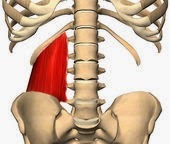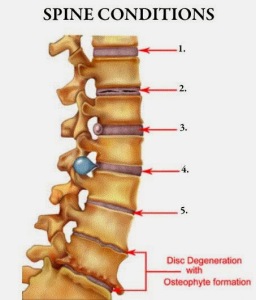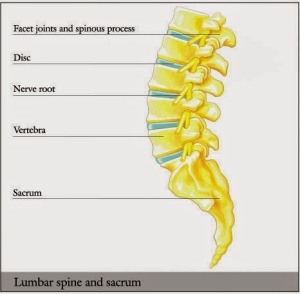THE ANATOMY OF THE LOWER BACK
The lumbar spine is made up of 5 vertebrae. Below the lumbar region are 5 fused vertebrae of the sacrum and the 5 fused vertebrae of the coccyx. A facet joint joins each pair of vertebra (i.e., the one above to the one below). Like hinges, the facet joints guide the movement of the spine, while also stabilizing the vertebral column.
Ideally, the joints in the spine are lined up so that the back can twist and bend with little friction between the vertebrae. Between each pair of vertebrae lies a flat, circular inter-vertebral disc. The outer part of the disc, the annulus, is strong and hard. The inner portion, the nucleus pulposus is soft and absorbs shocks to the spine during movement. Many times degenerative disc disease or other problems involving the disc can lead to unbearable back pain. This can be due to damage to the nerve.
The vertebrae surround and protect the spinal cord, a column of nerves running down from the brain. Nerves branch off from the spinal cord and with their roots passing through the vertebrae, extend all over the body. As a result, pain from a back problem may also travel to other parts of the body. This can cause numbness, tingling, pain, burning into the hips, legs, knees, feet, and even around to the abdominal region! One example is Sciatica.
CORE EXERCISES
Core exercises are excellent for aiding with problems of the lower back. Unfortunately they can cause issues with the lower back as well, if not performed properly and not the right type! People often will make use of the psoas muscle, hip flexor, too much and they also use the lower back joints when doing core – which places pressure on the spinal segments. Studies have indicated that people are aggravating their back when performing core exercises
The abdominal muscles can be engaged when sitting, standing, walking and running. If you think about placing your lower back/hips in ‘neutral’ alignment you are able to activate your core properly in these postures. Just think while doing any of these activities you can be working your core!
Please see the front bulletin board for instructions on how to obtain this neutral alignment! You can also ask Dr. Barbara Rodwin how to do this.
SITTING CAN CAUSE LOWER BACK PROBLEMS
As technology advances, we are spending more and more time sitting, often in front of a computer. People are also being less and less active. Sitting all the time wreaks havoc on your posture and can cause pain, stiffness and discomfort in the lower back, hips, and neck.
Sitting all the time can add excessive compression on the joints of the lower back. Many people think that sitting is better for the lower back than standing, but sometimes sitting can be worse than standing. When you sit down, all of your upper body weight is supported by your pelvis and lower back. However, if you are standing, the weight of your upper body is supported by your pelvis, lower back, hips, knees, and ankles.
Standing and sitting can both put pressure on the lower back but through slightly different mechanisms. In standing, if you have poor posture or poor core stability you may feel discomfort in your lower back, but sitting (especially with bad posture on a hard surface) will put more pressure on the joints of the lower back.
We do have a posture sheet explaining how to use your chair and sit properly!
LOWER BACK PROBLEMS
Lower back pain means relatively short-term pain, stiffness and/or muscle tension anywhere along the back, starting below the ribs and extending to just underneath the buttocks. If you are having lower back issues it is important that you have it examined by a Doctor of Chiropractic. A biomechanical exam will be performed which will determine if the problem is a lower back vertebrae/joint, muscle, and/or disc issues. Also we will determine if it is due to sitting, standing, lifting, walking, running, and/or sleeping habits.
During the course of the day if we use our back, abdominal, hip and trunk area properly we place very little pressure/stress on this region. If we are not using this area properly studies have indicated that we can put upwards of 150% greater force on the lower back. This extra force will over time lead to fatigue of the back and can cause spinal degeneration/arthritis in the lower back due to the repetitive stress placed on the vertebrae.
When this degeneration occurs to the vertebrae and discs this causes the lower back vertebrae to lose some of their normal motion. Our body then adapts by tensing the muscles to hold this area tighter. This will lead to stiffness in the long back muscles, also known as the erector spinae. You will feel this along the sides of the spine. All of this can then cause issues with the nerves that exit at each vertebrae.
Some people with lower back problems then feel it in their buttocks, backs of their legs, into their thighs, knees, shins and even into their feet!
As you can tell the lower back is very complex and involves many structures that can cause your lower back discomfort.




